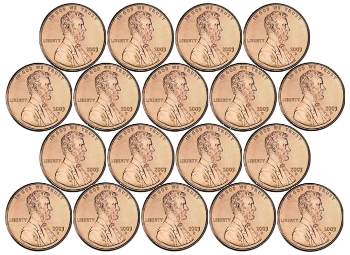
Particle Clumping
July 9, 2014 Since our earliest days, each of us has been concerned with the common human activities of packing and filling. As children, we needed to pack our toys in our toy chest and our clothes in our dresser drawers and closet. We needed to fill our bowl with breakfast cereal without its overflowing, and the same for cups of milk. Not surprisingly, there's a lot of science behind the optimal packing and filling of regularly- and irregularly-shaped items. As I wrote in a previous article (Packing and Filling, May 17, 2012) the optimal packing of circle in a plane occurs when their centers are on an hexagonal lattice. This packing gives an areal density of (π/2√3) = 0.9069 (see figure). Carl Friedrich Gauss proved that this packing was optimum for a lattice arrangement, and László Fejes Tóth showed that this is the optimal packing, lattice or otherwise.[1] | Lattice packing of pennies in a plane. (Base image of a US penny, via Wikimedia Commons.) |
 | Random packing of isosceles triangles in a plane using a variant of the Lubachevsky-Stillinger algorithm. (Illustration by L. Salgo, via Wikimedia Commons.) |
 |
| The well-known cannonball (close-packing) arrangement of spheres (right), along with the illustration that Johannes Kepler (1571-1630) used when making the conjecture that this is the densest possible arrangement. (Left image by "Greg L," and right image from Johannes Kepler's 1611 Strena Seu de Nive Sexangula, both images via Wikimedia Commons.) |
 | Monte Carlo simulation of packing of hard ellipses. (image from the ChaikinLab Condensed Matter Physics Laboratory at New York University.) |
 | Jessica Young, a high school student and an intern at NIST, doing a packing experiment. Young's work aided NIST research on how rigid aggregates tend to clump together at roughly the same density regardless of scale. (Image: Baum/NIST.) |
References:
- Weisstein, Eric W. "Circle Packing." From MathWorld--A Wolfram Web Resource.
- Weisstein, Eric W. "Kepler Conjecture." From MathWorld--A Wolfram Web Resource.
- Steven Schultz, "Sweet science: Common candies yield physics discovery," Princeton University Press Release, February 12, 2004.
- Aleksandar Donev, Ibrahim Cisse, David Sachs, Evan A. Variano, Frank H. Stillinger, Robert Connelly, Salvatore Torquato and P. M. Chaikin, "Improving the Density of Jammed Disordered Packings Using Ellipsoids," Science, vol. 303, no. 5660 (February 13, 2004), pp. 990-993.
- Aleksandar Donev, Frank H. Stillinger, P. M. Chaikin and Salvatore Torquato, "Superdense Crystal Packings of Ellipsoids," arXiv Preprint Server, March 10, 2004.
- S. Torquato, "Reformulation of the Covering and Quantizer Problems as Ground States of Interacting Particles," arXiv Preprint Server, September 8, 2010.
- Salvatore Torquato and Frank H. Stillinger, "Jammed Hard-Particle Packings: From Kepler to Bernal and Beyond," arXiv Preprint Server, August 17, 2010.
- S. Torquato and Y. Jiao, "Exact Constructions of a Family of Dense Periodic Packings of Tetrahedra," arXiv Preprint Server, April 30, 2010.
- Y. Jiao, F. H. Stillinger and S. Torquato, "Novel Features Arising in the Maximally Random Jammed Packings of Superballs," arXiv Preprint Server, January 4, 2010.
- S. Torquato and Y. Jiao, "Dense Packings of Polyhedra: Platonic and Archimedean Solids," arXiv Preprint Server, September 9, 2009.
- S. Torquato and Y. Jiao, "Dense Packings of the Platonic and Archimedean Solids," arXiv Preprint Server, August 27, 2009.
- S. Torquato, T. M. Truskett and P. G. Debenedetti, "Is Random Close Packing of Spheres Well Defined?," arXiv Preprint Server, March 25, 2000.
- Christopher D. Zangmeister, James G. Radney, Lance T. Dockery, Jessica T. Young, Xiaofei Ma, Rian You and Michael R. Zachariah, "Packing density of rigid aggregates is independent of scale," Proc. Natl. Acad. Sci. Early Edition, June 9, 2014, doi:10.1073/pnas.1403768111.
- Supporting information for ref. 13 (PDF File).
- Michael Baum, "Snowballs to Soot: The Clumping Density of Many Things Seems to Be a Standard," NIST Tech Beat, June 10, 2014.